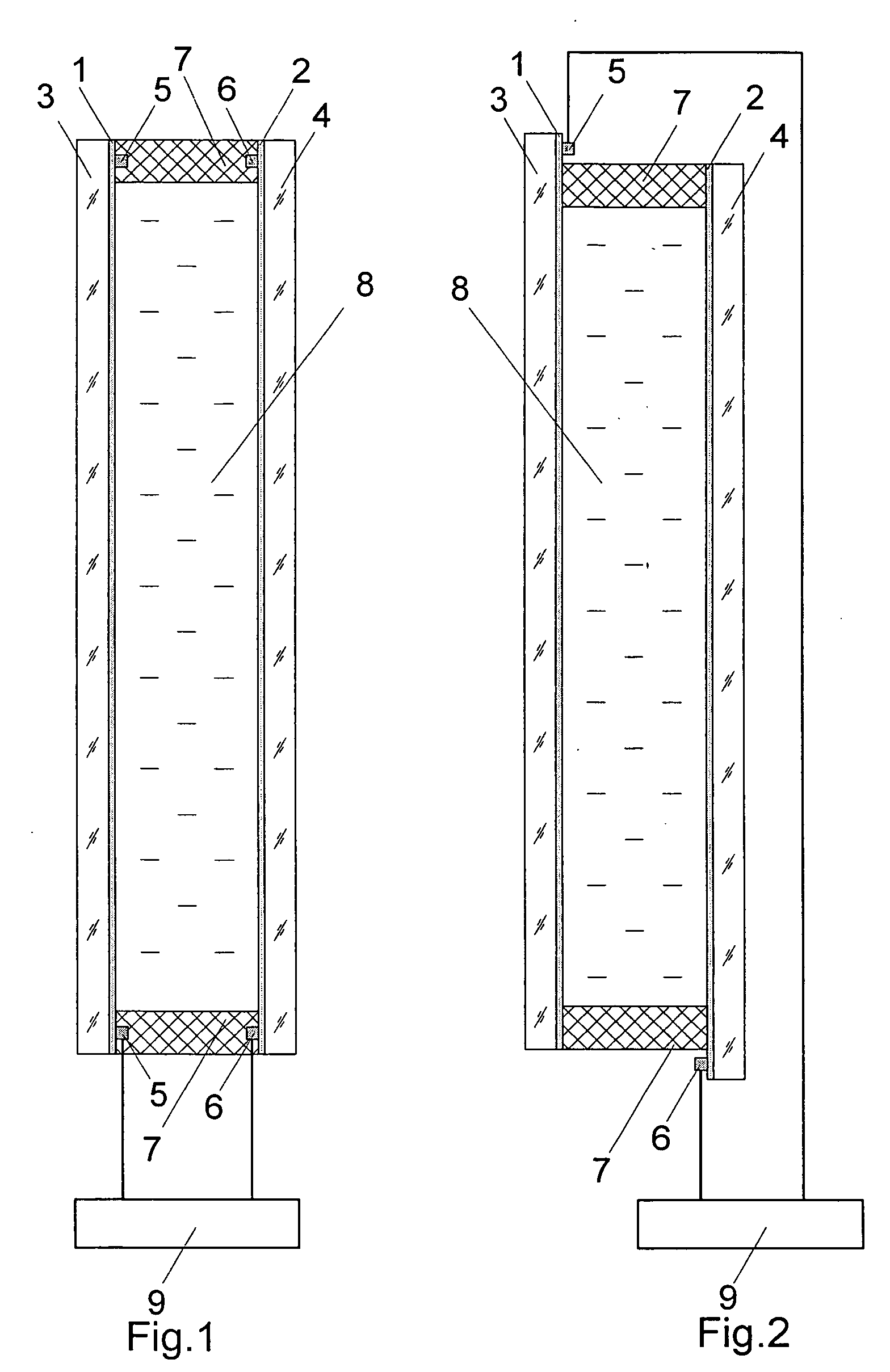Method for producing an electrochromic device and said electrochromic device
a technology of electrochromic devices and electrochromic devices, which is applied in the direction of optics, instruments, chemistry apparatuses and processes, etc., can solve the problems of limiting the workability of the device as a whole, unserviceable devices, and insufficient light attenuation efficiency of the prepared electrochromic devices, etc., to achieve higher stability, longer persistence of colouring and bleaching uniformity, and high stability of the electrochromic devices
- Summary
- Abstract
- Description
- Claims
- Application Information
AI Technical Summary
Benefits of technology
Problems solved by technology
Method used
Image
Examples
example 1
[0050] An electrochromic device comprising two optically transparent SnO2 electrodes with a surface electrical resistance of 18 ohm / m2 and a glass substrate thickness of 4 mm (K-glass, produced by Pilkington) was produced. The electrode dimensions were 20×30 cm2. The electrodes were shifted with respect to each other to ensure the current input along the longer side and were bonded along the perimeter by an epoxide-based adhesive containing spacers to form an inter-electrode gap of 0.4 mm. In the 5-mm wide glue line, an opening was left for filling the device with the initial electrochromic composition representing a disperse system in the form of a suspension, comprising the following components: a dispersion medium (electrochromic solution)—a solution of 0.01M 1,1′-dimethyl-4,4′-dipyridinium diperchlorate and 0.01M ferrocene in γ-butyrolactone; a disperse phase (20.7% wt)—the Vitan-2M copolymer. Prior to preparing the suspension, the electrochromic solution was cooled down to abou...
example 2
[0052] The electrochromic device was produced as in Example 1 except that the initial electrochromic composition was evacuated for 12 min before filling.
[0053] On the expiry of about 1.5 h at a temperature of 20° C., the uniformly dim initial electrochromic composition became transparent without emerging any visible air bubbles and without volume shrinkage. The light transmission of the device in the visible spectral region was 78%. On application of a direct voltage of 1.5 V to the device, the electrochromic layer acquired a uniformly blue colour over the window area, while upon short-circuiting of the electrodes, the light transmission of the device returned to the initial value. After unsealing of the device, the electrochromic composition was a solid-like film.
example 3
[0054] Two electrochromic devices with dimensions 50×100 cm2, each comprising two optically transparent SnO2-electrodes with a surface electric resistance of 18 ohm / m2 and a glass substrate thickness of 4 mm (K-glass) were produced. The electrodes were bonded together along the perimeter by the two-sided adhesive tape VHB 4910 with a thickness of 1 mm and a width of 6 mm with two openings for filling the device with the electrochromic disperse system. Along the longer side of each electrode, feed wires (copper conductors 0.2 mm in diameter) were laid under the adhesive tape and brought outside. The inner space of device No. 1 thus formed was filled, by injection, with the initial electrochromic composition representing a disperse system in the form of a suspension, comprising the following components: a dispersion medium (electrochromic solution)—a solution of 0.01M 1,1′-dimethyl-4,4′-dipyridinium diperchlorate and 0.01M ferrocene in a γ-butyrolactone (60% vol.)—propylene carbonate ...
PUM
| Property | Measurement | Unit |
|---|---|---|
| particle size | aaaaa | aaaaa |
| temperature | aaaaa | aaaaa |
| thickness | aaaaa | aaaaa |
Abstract
Description
Claims
Application Information
 Login to View More
Login to View More - R&D
- Intellectual Property
- Life Sciences
- Materials
- Tech Scout
- Unparalleled Data Quality
- Higher Quality Content
- 60% Fewer Hallucinations
Browse by: Latest US Patents, China's latest patents, Technical Efficacy Thesaurus, Application Domain, Technology Topic, Popular Technical Reports.
© 2025 PatSnap. All rights reserved.Legal|Privacy policy|Modern Slavery Act Transparency Statement|Sitemap|About US| Contact US: help@patsnap.com


